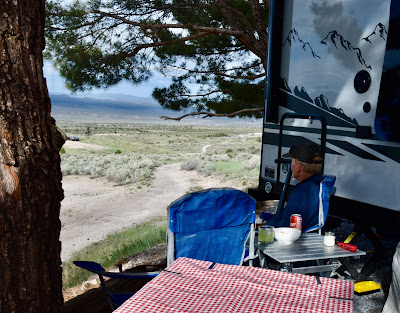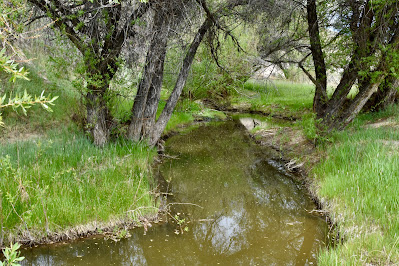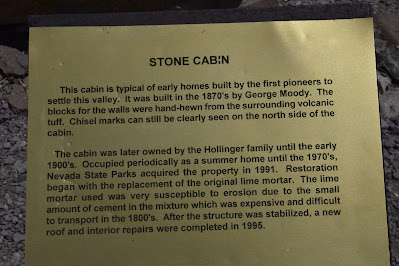What a find!
Our first full day in Pioche, Nevada: comfy in my camp chair, coffee at hand, snugged beneath the reaching sheltering pine-cone-laden arms of sturdy pines, savoring a wisp of cool breeze as multiple birds sing just out of sight and others greet me on their morning rounds.
A Bullock's oriole chatters, lights high up in the tree as it peruses our nectar feeder and moves on; a Woodhouse jay is attracted to our seed feeder as he boldly lands on a limb a few feet from me, but moves on without imbibing.
Our first day here, but we’ve already determined that this week will be only one of others to come. We came to try out the fishing but were quickly entranced with the town - alive and thriving but with a sense of times past. Pioche’s elevation, a bit more than Prescott’s mile high, allows it a view over a broad valley ringing it to continuous mountain ranges blue and and then lighter in hue into the distance.
A mining town above all else, made blatantly obvious by the multiple mine-pocked slopes rising behind the settlement itself, Pioche came into existence in 1864 when mineral veins of silver were discovered. A San Francisco transplanted Frenchman - François Louis Alfred Pioche - is immortalized in the town’s name and in the Pioche Hills that yielded their treasure. Early years are said to be some of the most lawless and deadly of western frontier settlements; today, however, we find it to be serene and picturesque. This is something we seldom find any more: a historic town that incorporates the new into the old without obliterating the historic, and most astounding of all - no big box bypass, not a chain store in sight and wonder of wonders: not a single dollar store.
Clearly I will go a little snap-happy shooting selected pics of the many mines and 19th century buildings, some long abandoned, some leaning out of square under the weight of years, some given new life repurposed for current-day uses.
By dint of casual observation after our late afternoon arrival and early morning outdoor breakfast, we have begun a substantial trip list of birds. We’ve enjoyed watching western kingbird, house sparrow, raven, collared dove, mourning dove, black-chinned hummingbird, broad-tailed hummingbird, northern mockingbird, fox sparrow, starling, turkey vulture, and a stunning mountain bluebird that claims one nearby stubbed-off limb as his special perch.
As we gaze down and across the valley, a ribbon of road beckons, and so we set off to find our way to nearby lakes.
Those lakes are what brought us to these parts, after all, so we want to discover whether reality lives up to the hype. We had never heard a whisper of anything about this country prior to our Emerald Cove kayak excursion on the Colorado River. It was then that I struck up a conversation with a couple of Las Vegas folks out for the day, and he revealed to me his favorite fishing spot. It is my humble opinion that if someone gives up his secret fishing hole, one ought to pay attention, so I did, and a few short weeks later: here we are.
Echo Canyon . . .
Lowest downstream on the Meadow Valley Wash is the Echo Canyon Reservoir, which we reached in short order. Its water level was far below full pond; nevertheless, the small lake looked inviting. Our exploration day turned out to be one of constant strong and gusting winds that would have been unpleasant for angling but worked out just fine for driving and sauntering walks one place and another.
At one spot, I counted 22 babies being carefully guarded by two mama Canada geese. Our presence induced them to move their broods into the shore brush for protection.
As we continued upstream, the channel narrowed on its course through the aptly named gorge and was spanned by an impressive footbridge, making a crossing possible for hikers along the canyon's trail.
In places, the bottomland was choked with Coyote willows . . .
In places, the canyon opened up as tributaries broke through varied geologic formations . . .
. . . and then constricted again into grassy-banked stream meanders with living canopies. We did not resist the implied invitation and walked into that water-led tunnel.
In the course of one of our saunters, we encountered a side wash that made me want to detour from our stream-side walk, but for a change, I went with the direction the señor headed. I definitely will return to that spot, though. In truth, a person could spend years wandering in that country and never make the slightest dent in what is there to be explored.
One intersecting side road splits a historic home site that has been abandoned in favor of a newer dwelling and outbuilding further on - worth a stop for photos and exploration on another day.
As we proceeded upstream, we encountered well-kept farms and ranches with grass and alfalfa fields sprinkler irrigated everywhere the canyon floor widened to accommodate them. I was interested by the one pictured below where a new field has been cleared of the ubiquitous sagebrush and appears ready to plant.
Interesting country in that you can easily see the layers of vegetation all at the same time: canyon-bottom deciduous trees on a bed of grass just below vast areas of sage that are topped by hillsides of piñon juniper. And still lots of variety in the underlying rock formations, including shale, mountains of dark volcanic rock, and light volcanic tuff that is wind-shaped into fantasmagorical swirls and shapes.
Eagle Valley, Spring Valley . . .
Along the way as expected, we came to Eagle Valley Lake, a larger and full-to-the-brim reservoir. It looked pretty fishable alright, as promised, and some folks were trying their luck from the shore. A couple were even out in boats, which seemed to me exceedingly unpleasant in that wind.
Also as expected, the presence of abundant water in the desert attracted 19th-century settlers who carved out a life in that far-from-civilization outpost. It was way out then, and actually, it's way out now. Lincoln County, where we find ourselves, is populated by a mere 5,000 or so folks even today despite its size as the 7th largest county in the U.S., which explains the absence of the chain emporiums that have become standard throughout our nation.
We visited several old homesteads, many of which were constructed of local rock by master masons.
We were left scratching our heads in a quandary about something pictured here. The burned trees in the yard were not torched at that site, but were later stuck into the ground in front of this house and each is supported by a metal fence post! The only possible explanation that occurs to me is that they were put in place for effect for a movie shoot. If someone has a better idea, I'd like to hear it.
The next stone cabin is evidently furnished with period pieces and maintained by Nevada State Parks, although it was not open when we were there.
We were able to go into the accompanying root cellar, a structure that took an amazing amount of work to construct, from excavating the sizable hole in rocky ground to building walls with large rocks, to cutting and hauling sturdy juniper posts to build a roof and covering it with sod. Those were some tough folks!
And speaking of those folks, that homestead was actually signed about its origin; however, my research indicated a glitch in their explanation. It was supposedly built by George Moody in the 1870s, but later, in 1880, said George was a 20-year-old living there with his parents. He didn't marry until 1885, so I suspect that it was his father who built the house.
The sign also informed us that the Hollinger family resided there until the early 1900s. A quick look turned up an interesting tidbit about that bunch: they were four brothers from Ireland. The oldest is listed as a quartz miner, which is a bit puzzling unless maybe he was quarrying rock for buildings, and his brothers are stock raisers and farmers.
Ruins throughout the valley attest to the tenacity of folks to carve out their niche in the world.
The source of the stream through Meadow Valley Wash and that feeds Eagle Valley and Echo Canyon reservoirs is in Spring Valley, a vast sub-irrigated bottomland, said to have so many springs that 150 were located in only one day.
Our day-long explore through that drainage gave us ample opportunities for scrambling up and over tuff formations and many other side jaunts through a great variety of countryside.
Upon our return to town, we were not quite satisfied with stopping, so we did a bit of backroading up into the Pioche Hills and over to a mostly-gone mining town of Caselton.
Along the way, we took a few shots of mines and structures around Pioche.
Mostly back up the canyon, we added to the bird list: American coot, great blue heron, cinnamon teal, mallard, red-winged
blackbird, turkey, violet-green swallow, common grackle, Say's Phoebe,
western meadowlark.












































No comments:
Post a Comment